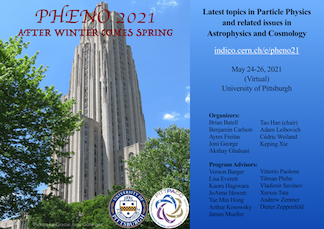Speaker
Description
The Standard Model (SM) explaining the framework of elementary particles seems to be completed
by the discovery of the SM-like Higgs boson with a mass of about 125 GeV at the Large Hadron
Collider(LHC) in 2012. Despite this success, there are enough experimental evidences, ranging
from observed dark matter (DM) relic density and matter-antimatter asymmetry in the universe
to non-zero neutrino mass, which indicates the existence of beyond SM theories. It is also known
from the theoretical viewpoint that the SM by itself cannot ensure the electroweak (EW) vacuum
stability till the Planck scale. It is observed that an additional scalar sector with bosonic
degrees of freedom can ease the stability issue, by compensating for the destabilizing effect of the
top-quark Yukawa coupling on the renormalization group (RG) evolution of the SM Higgs quartic
coupling. We observed that extension with singlet right-handed neutrinos (RHNs) destabilizes
the potential while in extensions with SU(2) triplet fermions, weak gauge coupling g-2 shows
contrasting behaviour compared to SM and enhances the stability. Extension with singlet right-
handed neutrinos or triplet fermions generated the eV light neutrino mass via seesaw mechanism
while scalar sector i.e. Inert Higgs doublet or Higgs triplet provides a dark matter candidate. After
the theoretical constraints from Planck scale perturbativity and vacuum stability we focussed on
the DM constraints from DM relic density, direct detection and indirect detection of DM. For
the freeze-out scenario, the universe started with a large population of DM that was in thermal
equilibrium with the bath. As the universe expands, the temperature falls down and the dark
matter particles are not able to find each other fast enough to maintain the equilibrium abundance.
So when the equilibrium ends and the freeze-out starts, inert particles can contribute to the DM
relic density through freeze-out mechanism. Firstly, DM can be detected by the so-called direct
detection method via elastic scattering with terrestrial detectors and the quantity that determines
the direct detection rate is the dark matter-nucleon (DM-N) scattering cross-section. Secondly, the
Indirect detection of dark matter is also an interesting way to probe particle dark matter models.
Galactic centre and Dwarf Spheroidal Galaxies (dSphs) are amongst the few targets, where dark
matter annihilate or semi-annihilate into electron, positron, neutrinos, etc. and yield excess of
gamma rays of different energies which are then observed by various telescopes. We estimated
the indirect cross-section constraints for the dominant modes from H.E.S.S. and Fermi-Lat
experiments. We also estimated the production cross-sections for various associated Higgs-DM
production modes at the LHC for the centre of mass energy of 14, 100 TeV in inert Higgs doublet
and inert Higgs triplet (ITM) respectively. It is observed that the compressed spectrum for ITM
will easily lead to displaced mono- or di-charged leptonic or displaced jet final states along with
missing energy while in case of IDM such displaced case is not so natural. We use an extensive
numerical set up, using Calchep, Micromegas 5.0.8, Madgraph, Pythia, Delphes and
Machine learning techniques.

